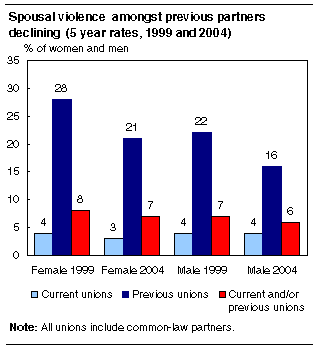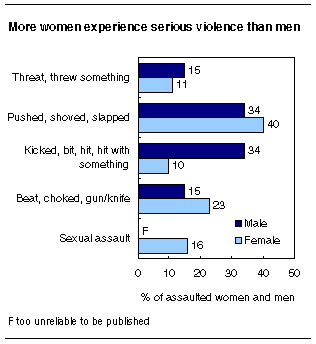
















 |
|
 |                |
Information identified as archived is provided for reference, research or recordkeeping purposes. It is not subject to the Government of Canada Web Standards and has not been altered or updated since it was archived. Please "contact us" to request a format other than those available.

|

Thursday, July 14, 2005 Family violence in Canada: A statistical profile2005An estimated 7% of women and 6% of men in a current or previous spousal relationship encountered spousal violence during the five years up to and including 2004, according to a comprehensive new report on family violence. 
The report, which uses data from the 2004 General Social Survey (GSS), showed that the overall five-year rate of spousal violence has remained unchanged at 7% since 1999. This means that an estimated 653,000 women and 546,000 men encountered some form of violence by a current or previous spouse or common-law partner. Rates of spousal violence were highest among certain segments of the population: those aged 15 to 24; those in relationships of three years or less; those who had separated; and those in common-law unions. However, rates of spousal violence amongst previous partners who had had contact with their former partner in the past five years declined from 28% in 1999 to 21% in 2004 for women and from 22% to 16% for men. While about three-quarters of these individuals indicated that the violence occurred during the marital or common-law union, one-half of women victims and one-third of men victims said the violence either continued or occurred after separation. Data show that the nature and consequences of spousal violence were more severe for women than for men. Female victims of spousal violence were more than twice as likely to be injured as male victims. Women were also three times more likely to fear for their life, and twice as likely to be the targets of more than 10 violent episodes.
This report also provides information on stalking, otherwise known as criminal harassment, and family related homicide-suicides. Overall, 11% of women and 7% of men aged 15 and older stated that they were stalked in a way that caused them to fear for their safety or the safety of someone close to them. This was the equivalent of 1.4 million women and just under one million men. Among victims of stalking, 9% of women reported that they had been stalked by either a current or previous spouse, or a common-law partner, twice the proportion of 4% among men. Between 1961 and 2003, 1 in 10 solved homicides were cases in which the suspect took his or her own life following the homicide. About three-quarters of these victims of homicide-suicides were killed by a family member. Spousal violence: Risk factorsRates of spousal violence were found to be highest among certain segments of the population. People who were aged 15 to 24 were more than twice as likely to be victims of spousal violence as those 35 and older. Rates were three times higher in relationships of three years or less than relationships that were more than ten years in duration. Data also showed that rates of spousal violence were three times more likely in common-law relationships than marital unions. 
People whose partner was a heavy drinker (a heavy drinker was defined as someone who consumes five or more drinks on five or more occasions in a given month) were six times more likely to experience spousal violence than those whose partner never drank in excess of five drinks. In cases of current relationships in which emotional abuse existed, 25% of women and 19% of men experienced violence. Examples of emotional abuse include being isolated from family and friends, having no access to family income, or having property or possessions destroyed. In contrast, in current relationships where there was no emotional abuse, 1% of women and 2% of men experienced violence. The survey indicates that the risk of violence is particularly elevated at the time of separation, especially in the case of women. One-third (34%) of women who experienced violence during their relationship said that the violence increased in severity or frequency after separation. The number of men who reported violence during their relationship was too small to produce reliable estimates. Data suggest that Aboriginal people were three times more likely to be victims of spousal violence. Overall, 21% of Aboriginal people, or 24% of Aboriginal women and 18% of Aboriginal men, said that they had suffered violence from a current or previous spouse or common-law partner in the five-year period up to 2004. This was the case for 7% of non-Aboriginal people. Aboriginal victims were also more likely to state that they were beaten, choked, threatened with or had a gun or knife used against them, or were sexually assaulted. Severity of spousal violence greater for womenOverall, the survey found that women were more likely to experience more serious forms of spousal violence than men. Nearly one-quarter (23%) of female victims reported that the most serious form of violence experienced was being beaten, choked, or threatened by having a gun or knife used against them. This was the case for 15% of male victims. About 44% of female victims of spousal violence indicated that they suffered injury because of the violence, more than twice the proportion of 19% among male victims. In addition, 13% of female victims sought medical attention, compared with only 2% of male victims. Over one-third of women victims said that the violence was reported to the police, compared to 17% of men victims. In addition, 38% of women who reported to the police also sought a restraining order, more than twice the proportion of men. Stalking: Women twice as likely to be harassed by previous partnerAccording to the General Social Survey, 9% of the population aged 15 and over, or 2.3 million people, were stalked in the five-year period up to 2004. Stalking includes repeated and unwanted attention that causes a person to fear for their safety or the safety of someone known to them, such as receiving obscene phone calls, being spied on, or being intimidated or threatened. Among those who were stalked, the majority knew their stalkers, as less than one-quarter of victims were harassed by a stranger. Female victims of stalking were more likely than male victims to report being stalked by an ex-intimate partner, including previous spouses and boyfriends. Conversely, male victims were more likely than female victims to be harassed by an acquaintance. Overall, female victims were twice as likely as male victims to be stalked by a previous spouse. Similarly, 11% of female victims and 6% of male victims reported being stalked by a previous boyfriend or girlfriend. Only 1% of female victims reported being stalked by a current spouse or boyfriend. The number of men stalked by a current partner was too small to produce reliable estimates. 
Victims pursued by a stalker with whom they had had an intimate relationship were more likely to be stalked for a longer period of time relative to those who were stalked by a stranger or an acquaintance. Over 60% of stalking victims pursued by an ex-spouse were harassed for over one year. Those stalked by a previous spouse were also more likely to report to the police. About 49% of stalking victims pursued by a previous spouse reported the stalking to the police, compared with just over one-third of victims pursued by a stranger or an acquaintance. Victims who were stalked by a previous spouse were more likely to seek a restraining order. Over one-third of those stalked in these situations reported seeking a restraining order. In contrast, 13% of those stalked by someone from a previous dating relationship sought an order, as did 11% of those stalked by an acquaintance and 4% stalked by a stranger. Homicide-suicides among familiesBetween 1961 and 2003, there were 1,994 cases of solved homicides in which the suspect took his/her own life following the homicide. These cases represented 10% of all solved homicides. About three-quarters of victims of homicide-suicides were killed by a family member, while the remainder involved an acquaintance or a stranger. Over one-half (57%) of family homicide-suicides involved spouses, and of these incidents, virtually all (97%) involved female victims killed by a male spouse. Since 1991, when data became available to distinguish between the various types of spousal relationships, victims of spousal homicide-suicide were killed by a legally married (42%), separated (30%), common-law (23%) or a divorced husband (3%). About 2% of spousal homicide-suicide victims were male spouses killed by a female spouse. One-quarter of the homicide-suicides, which occurred between 1961 and 2003, involved children and youth aged 18 and under. The vast majority of these were family-related. The accused involved in family-related homicide-suicides against a child or youth was most often a parent of the victim. In 66% of cases, the accused was the father, in 27% the mother, and in 2% a step-father. Parent-child homicide-suicides often involved multiple victims. About 35% of cases involved two victims, while 36% involved three to five victims, and 28% of incidents involved one victim. Definitions, data sources and methods: survey numbers, including related surveys, 3302, 3315 and 4504. The report Family Violence in Canada: A Statistical Profile (85-224-XIE, free) is now available online. From the Our products and services page, under Browse our Internet publications choose Free, then Justice. A hard copy is also available from the National Clearinghouse on Family Violence. To obtain a copy, call (1-800-267-1291; 613-957-2938). For more information, or to enquire about concepts, methods or data quality of this release, contact Information and Client Services (1-800-387-2231; 613-951-9023), Canadian Centre for Justice Statistics. |
|
|
|